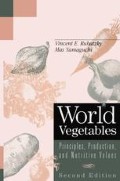Abstract
Solanaceae is mainly a tropical family of about 75 genera and 2000 species. The more important vegetable genera are Solanum (potato and eggplant), Lycopersicon (tomato), and Capsicum (pepper). The Solanaceae, widely known as the nightshade family, also includes some poisonous alkaloid-containing species such as belladonna (Atropa belladonna), mandrake (Mandragora officinarum), henbane (Hyoscyamusniger), Jimson weed (Datura stramonium), climbing nightshade (Solanumdulcamara), and widely used tobacco (Nicotiana tabacum). Some genera, particularity Solanum, can be extremely poisonous and caution is advised before consumption. The potato, Solanum tuberosum, is discussed in Chapter 9. Following are some of the cultivated solanaceous vegetables, most, with the exception of Chinese box thorn, are grown for their edible fruit.
Access this chapter
Tax calculation will be finalised at checkout
Purchases are for personal use only
Preview
Unable to display preview. Download preview PDF.
Selected References
Alcazar-Esquinas, J.T. 1981. Genetic Resources of Tomatoes and Wild Relatives. International Board for Plant Genetic Resources (IPGRI), Rome, Italy.
Andrews, J. 1984. Peppers: The Domesticated Capsicums. University of Texas Press, Austin, Texas.
Atherton, J.G., and Rudich, J., eds. 1986. The Tomato Crop-A Scientific Basis for Improvement. Chapman Hall, London.
Bianco, V.V., and Pimpini, F., eds. 1990. Orticoltura. Patron Editore, Bologna, Italy.
Bieche, B., ed. 1990. Third International Symposium on Processing Tomatoes, Avignon, France. Acta Hortic. No. 277.
Cantwell, M., Flores-Minutti, J., and Trejo-Gonzalez, A. 1992. Developmental changes and postharvest physiology of tomatillo fruits, (Physalis ixocarpa Brot.). Sci. Hortic. 50, 59–70.
Dumas, Y. 1990. Tomatoes for processing in 90’s: Nutrition and crop fertilization. Acta Hortic. 277, 155–166.
El-Beltagy, A.S., and Persson, A.R., eds. 1986. Symposium on Tomato Production in Arid Land. Acta Hortic. No. 190.
Eshbaugh, W.H., Guttman, S.I., and McLeod, M.J., 1983. The origin and evolution of domesticated Capsicum species. Ethnobiology 3, 49–54.
Heiser, C.B. 1969. Love apples. In Nightshades: The Paradoxical Plants. Freeman, San Francisco.
Huffman, V.L., Schadle, E.R., Villaion, B., and Bums, E.E. 1978. Volatile components and pungency in fresh and processed Jalapeno peppers. J. Food Sci. 43:1809–1811.
Kim, K.Y., Takahashi, K., and Nagaoka, M. 1982. Effect of light intensity, night temperature and CO2 concentration on the growth, yield and quality of glasshouse tomato. J. Korean Soc. Hort. Sci. 23, 93–108.
Kopeliovitch, E., Rabinowitch, H.D., Mizrabi, Y., and Keder, N. 1979. The potential of ripening mutants for extending storage life of tomato fruit. Euphytica 28, 99–104.
Maissoneuve, B. 1982. Effect d’un traitment a basses temperatures en conditions controlee sur la qualite du pollen de tomate (Lycopersicon esculentum Mill.). Agronomie 2, 755–764.
McLeod, M.J., Guttman, S.I., and Eshbaugh, W.H. 1982. Early evolution of chili peppers (Capsicum). Econ. Bot. 36, 361–368.
Nevins, D.J., and Jones, R.A., eds. 1987. Proc. Symposium on Tomato Biotechnology. Univ. California, Davis, Aug. 20–22, 1986. Alan R. Liss, Inc., New York.
Nothman, J., Rylski, I., and Spigelman, M. 1979. Flowering pattern, fruit growth and color development of eggplant during the cool season in a subtropical climate Sci. Hortic. 11, 217–222.
O’Brien, M. 1980. Tomato harvesting, post-harvest handling and transportation. Acta Hortic. 100, 239–249.
Picha, D.H. 1987. Sugar and organic acid content of cherry tomato fruit at different ripening stages. HortScience 22, 94–96.
Quiros, C.E. 1985. Overview of the genetics and breeding of husk tomato. HortScience 19, 872–874.
Rick, C.M. 1978. The tomato. Sci. Am. 239, 76–87.
Rick, C.M., DeVerna, J.W., Chetelat, R.T., and Stevens, M.A. 1987. Potential contributions of wide crosses to improvement of processing tomatoes. Acta Hortic. 200, 45–55.
Rush, D.W., and Epstein, E. 1981. Breeding and selection for salt tolerance by the incorporation of wild germplasm into a domestic tomato. J. ASHS 106, 699–704.
Smith, P.G., Villalon, B., and Villa, P.L. 1987. Horticultural classification of peppers grown in the United States. HortScience 22, 11–13.
Tanksley, S.D., and Hewitt, J.D. 1988. Use of molecular markers in breeding for soluble solids content in tomato—a re-examination. Theor. Appl. Genet. 75, 811–823.
Tigchelaar, E.C. 1987. Genetic improvement of tomato nutritional quality. In Horticulture and Human Health. B. Quebedeux and F.A. Bliss, eds. Prentice-Hall, Englewood Cliffs, NJ, pp. 185–190.
Tiwari, R.N., and Choudhury, B. 1986. Solanaceous crops. Tomato. In Vegetable Crops in India. T.K. Bose and M.G. Som, eds. Naya Prokash, Calcutta, pp. 248–292.
Villareal, R.L. 1980. Tomatoes in the Tropics. Westview Press, Boulder, CO.
Warnock, S. 1974. Tomato development in California in relation to heat unit accumulation. HortScience 8, 487–488.
Watterson, J. 1985. Tomato Diseases: A Practical Guide for Seedsmen, Growers and Agricultural Advisors. Petoseeds Co., Saticoy, CA.
Wittwer, S.H., and Honma, S. 1979. Greenhouse Tomatoes, Lettuce and Cucumbers. Michigan State University Press, East Lansing, MI.
Author information
Authors and Affiliations
Rights and permissions
Copyright information
© 1997 Springer Science+Business Media Dordrecht
About this chapter
Cite this chapter
Rubatzky, V.E., Yamaguchi, M. (1997). Tomatoes, Peppers, Eggplants, and Other Solanaceous Vegetables. In: World Vegetables. Springer, Boston, MA. https://doi.org/10.1007/978-1-4615-6015-9_23
Download citation
DOI: https://doi.org/10.1007/978-1-4615-6015-9_23
Publisher Name: Springer, Boston, MA
Print ISBN: 978-1-4613-7756-6
Online ISBN: 978-1-4615-6015-9
eBook Packages: Springer Book Archive

